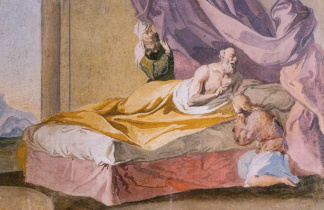Jacob used the laying on of hands ritual to not only confer on the two boys his family's name (Genesis 48:16) but also to transfer to them the right to receive God's birthright blessings (verses 16, 19 - 20).
And Israel stretched out his right hand and laid it upon Ephraim’s head, who was the younger, and his left upon Manasseh’s head, crossing his hands, for Manasseh was the firstborn . . .
(Israel said) The Angel Who has redeemed me from all evil, bless the lads. And let my name be perpetuated in them, and the name of my fathers Abraham and Isaac, and let them grow into a multitude in the midst of the earth (Genesis 48:14, 16, HBFV).
The practice of laying hands on individuals is considered one of the foundational doctrines of the New Testament church. The Apostle Paul encourages Christians, in the book of Hebrews, to build and grow upon this and other basic teachings in their walk as true believers.
Therefore, advancing beyond the beginning principles of the doctrines of Christ, we should go on to perfection; not laying again the foundation of repentance from dead works, and of faith in God, of the doctrine of baptisms, and of laying on of hands, and of the resurrection of the dead, and of eternal judgment . . . (Hebrews 6:1 - 2).
The laying on of hands was frequently used in ancient Israel's sacrificial system. If it was deemed the nation sinned, bringing guilt upon all, the tribal elders were required to collectively offer a sacrifice. They were to bring a young bull to the tabernacle, confess the nation's sins upon the animal's head, and then have it killed (Leviticus 4:13 - 21).
The laying on of a person's hands, upon an animal, was also performed once a year by the High Priest. On the Day of Atonement he would confess the nation's sins on a live goat and then release it to the wilderness (Leviticus 16:20 - 22).

This Old Testament ritual continued uninterrupted in the New Testament. It transformed, however, into a ceremony that more perfectly displayed God's miraculous power, love and mercy. In the early church, it was performed by more people for more purposes than in any other time in Biblical history.
Jesus Did It
Jesus performed not only the laying on of hands ceremony in order to heal people (Mark 6:5, Luke 4:40, etc.) he also used it to bless them. The miraculous act of healing not only showed the Eternal's mercy toward the sick, it also glorified his name (John 14:13).
What is referred to as the Great Commission included the power (according to God's will) to heal those through laying hands on them.
And He (Jesus) said to them, "Go into all the world and preach the gospel to the whole creation . . . And these signs shall follow those who believe: in My name they shall cast out demons; they shall speak with new languages;
"They shall remove serpents; and if they drink any deadly thing, it shall not hurt them in any way; they shall lay hands on the sick, and they shall recover." (Mark 16:15, 18, see also Acts 9:17, 28:1 - 9 and James 5:13 - 15).
A New Testament Practice
Laying hands on new believers to ask God to grant them the Holy Spirit was also a common occurrence in the New Testament. Peter and John performed this act on those in Samaria (Acts 8:14 - 17) and Paul himself received the spirit after being baptized (Acts 9:17). Paul would later perform this simple ceremony in Ephesus.
And Paul said, "John (the Baptist) truly baptized with a baptism unto repentance, saying to the people that they should believe in Him Who was coming after him - that is, in Jesus, the Christ."
And after hearing this, they were baptized into the name of the Lord Jesus. Now when Paul laid his hands on them, the Holy Spirit came upon them, and they spoke with other languages and prophesied (Acts 19:4 - 6).
Hands laid on an individual to set him apart for a special service was also utilized in the New Testament. Brethren used this ceremony, at the behest of the apostles, to anoint seven men to oversee the daily needs of the church (Acts 6:1 - 6). Paul and Barnabas were set apart to preach the gospel through this ceremony (Acts 13:1 - 2).
Lastly, Paul admonished his close friend Timothy to not neglect his gifts and calling given to him through the laying on of hands (1Timothy 4:14, 2Timothy 1:6).